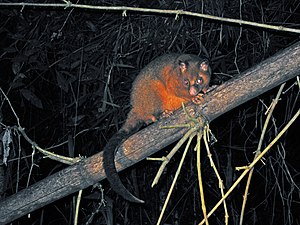Queensland Kusu
| Queensland Kusu | ||||||||||||
|---|---|---|---|---|---|---|---|---|---|---|---|---|

Queensland kusu ( Trichosurus johnstonii ) |
||||||||||||
| Systematics | ||||||||||||
|
||||||||||||
| Scientific name | ||||||||||||
| Trichosurus johnstonii | ||||||||||||
| ( Ramsay , 1888) |
The Queensland kusu ( Trichosurus johnstonii ) is an Australian marsupial that is endemic to northern Queensland on the western side of the Atherton Tablelands from Koombooloomba National Park to Kuranda .
features
The animals reach a head trunk length of 35.5 to 43.8 cm, have a 33 to 42 cm long tail and reach a weight of 1.2 to 2 kg. In contrast to the fox kusu , which occurs in the same area, they do not show any pronounced sexual dimorphism , only the skull of the males is slightly larger. The Queenland kusu can be easily distinguished from the gray fox kusu by its orange-brown to reddish-brown fur. Its bushy tail is blackish and proportionally longer, the ears are smaller and the molars are larger than those of the fox kusu.
Habitat and way of life
The Queensland kusu occurs mainly on the edges of the rainforests and the adjacent high, open forests. A study from a rainforest found a population density of three to four individuals per hectare. The animals are nocturnal and spend the day in tree hollows. They prefer to feed on leaves, but other parts of the plant make up about a third of their diet, especially the green fruits of various nightshade plants ( Solanum ). A total of 33 species of plants have been identified as contributing to the diet of the Queensland kusu. Most young are born in June, although the Fox Kusu gives birth to its young. Predators that chase the Queensland kusu are mainly snakes, owls and birds of prey.
Danger
The IUCN does not list the Queensland kusu yet, as it was previously considered a subspecies of the fox kusu. The Queensland kusu has probably lost a large part of its habitat in the past through clearing. However, today's stock is considered stable.
supporting documents
- ↑ a b c Kristofer Helgen & Stephen Jackson: Family Phalangeridae (Cuscuses, Brush-tailed Possums and Scaly-tailed Possum). In: Don E. Wilson , Russell A. Mittermeier : Handbook of the Mammals of the World - Volume 5. Monotremes and Marsupials. Lynx Editions, 2015, ISBN 978-84-96553-99-6 , p. 483